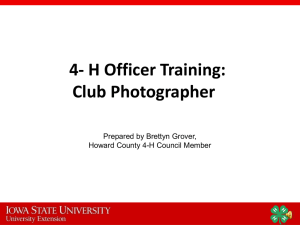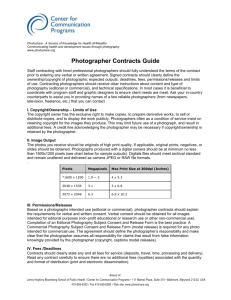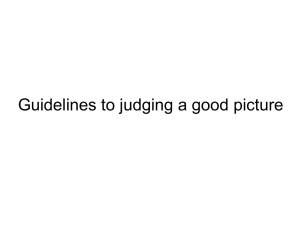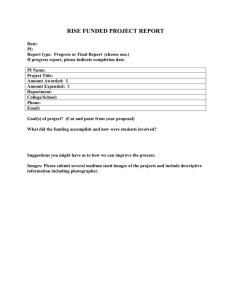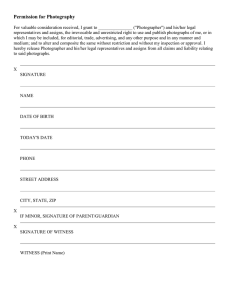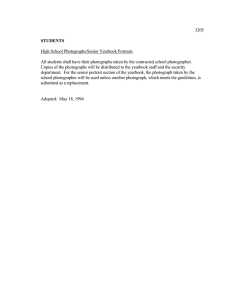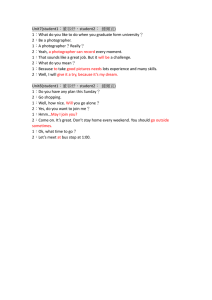Seeing Behind the Camera: Identifying the Authorship of a Photograph
advertisement
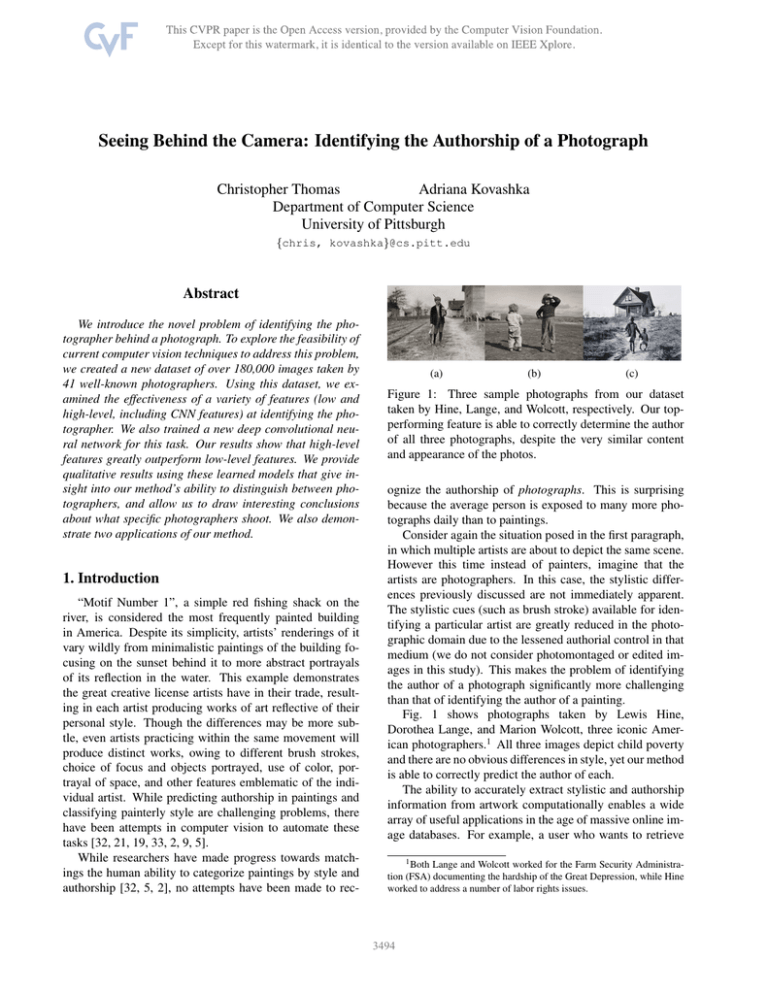
Seeing Behind the Camera: Identifying the Authorship of a Photograph
Christopher Thomas
Adriana Kovashka
Department of Computer Science
University of Pittsburgh
{chris, kovashka}@cs.pitt.edu
Abstract
We introduce the novel problem of identifying the photographer behind a photograph. To explore the feasibility of
current computer vision techniques to address this problem,
we created a new dataset of over 180,000 images taken by
41 well-known photographers. Using this dataset, we examined the effectiveness of a variety of features (low and
high-level, including CNN features) at identifying the photographer. We also trained a new deep convolutional neural network for this task. Our results show that high-level
features greatly outperform low-level features. We provide
qualitative results using these learned models that give insight into our method’s ability to distinguish between photographers, and allow us to draw interesting conclusions
about what specific photographers shoot. We also demonstrate two applications of our method.
1. Introduction
“Motif Number 1”, a simple red fishing shack on the
river, is considered the most frequently painted building
in America. Despite its simplicity, artists’ renderings of it
vary wildly from minimalistic paintings of the building focusing on the sunset behind it to more abstract portrayals
of its reflection in the water. This example demonstrates
the great creative license artists have in their trade, resulting in each artist producing works of art reflective of their
personal style. Though the differences may be more subtle, even artists practicing within the same movement will
produce distinct works, owing to different brush strokes,
choice of focus and objects portrayed, use of color, portrayal of space, and other features emblematic of the individual artist. While predicting authorship in paintings and
classifying painterly style are challenging problems, there
have been attempts in computer vision to automate these
tasks [32, 21, 19, 33, 2, 9, 5].
While researchers have made progress towards matchings the human ability to categorize paintings by style and
authorship [32, 5, 2], no attempts have been made to rec-
(a)
(b)
(c)
Figure 1: Three sample photographs from our dataset
taken by Hine, Lange, and Wolcott, respectively. Our topperforming feature is able to correctly determine the author
of all three photographs, despite the very similar content
and appearance of the photos.
ognize the authorship of photographs. This is surprising
because the average person is exposed to many more photographs daily than to paintings.
Consider again the situation posed in the first paragraph,
in which multiple artists are about to depict the same scene.
However this time instead of painters, imagine that the
artists are photographers. In this case, the stylistic differences previously discussed are not immediately apparent.
The stylistic cues (such as brush stroke) available for identifying a particular artist are greatly reduced in the photographic domain due to the lessened authorial control in that
medium (we do not consider photomontaged or edited images in this study). This makes the problem of identifying
the author of a photograph significantly more challenging
than that of identifying the author of a painting.
Fig. 1 shows photographs taken by Lewis Hine,
Dorothea Lange, and Marion Wolcott, three iconic American photographers.1 All three images depict child poverty
and there are no obvious differences in style, yet our method
is able to correctly predict the author of each.
The ability to accurately extract stylistic and authorship
information from artwork computationally enables a wide
array of useful applications in the age of massive online image databases. For example, a user who wants to retrieve
1 Both Lange and Wolcott worked for the Farm Security Administration (FSA) documenting the hardship of the Great Depression, while Hine
worked to address a number of labor rights issues.
3494
more work from a given photographer, but does not know
his/her name, can speed up the process by querying with a
sample photo and using “Search by artist” functionality that
first recognizes the artist. Automatic photographer identification can be used to detect unlawful appropriation of others’ photographic work, e.g. in online portfolios, and could
be applied in resolution of intellectual property disputes. It
can also be employed to analyze relations between photographers and discover “schools of thought” among them. The
latter can be used in attributing historical photographs with
missing author information. Finally, understanding a photographer’s style might enable the creation of novel photographs in the spirit of a known author.
This paper makes several important contributions: 1) we
propose the problem of photographer identification, which
no existing work has explored; 2) due to the lack of a relevant dataset for this problem, we create a large and diverse
dataset which tags each image with its photographer (and
possibly other metadata); 3) we investigate a large number of pre-existing and novel visual features and their performance in a comparative experiment in addition to human baselines obtained from a small study; 4) we provide numerous qualitative examples and visualizations to
illustrate: the features tested, successes and failures of the
method, and interesting inferences that can be drawn from
the learned models; 5) we apply our method to discover
schools of thought between the authors in our dataset; and
6) we show preliminary results on generating novel images
that look like a given photographer’s work.2
The remainder of this paper is structured as follows.
Section 2 presents other research relevant to this problem
and delineates how this paper differs from existing work.
Section 3 describes the dataset we have assembled for this
project. Section 4 explains all of the features tested and
how they were learned, if applicable. Section 5 contains
our quantitative evaluation of the different features and an
analysis of the results. Section 6 provides qualitative examples, as well as two applications of our method. Section 7
concludes the paper.
2. Related Work
The task of automatically determining the author of a
particular work of art has always been of interest to art historians whose job it is to identify and authenticate newly
discovered works of art. The problem has been studied by
vision researchers, who attempted to identify Vincent van
Gogh forgeries, and to identify distinguishing features of
painters [31, 14, 19, 10]. While the early application of art
analysis was for detecting forgeries, more recent research
has studied how to categorize paintings by school (e.g.,
2 Automatically creating a novel Rembrandt painting [1] gained media
attention in April 2016, five months after we submitted our work.
“Impressionism” vs “Secession”) [32, 21, 19, 33, 2, 5, 7].
[32] explored a variety of features and metric learning approaches for computing the similarity between paintings
and styles. Features based on visual appearance and image transformations have found some success in distinguishing more conspicuous painter and style differences
in [7, 33, 21], all of which explored low level-image features on simple datasets. Recent research has suggested that
when coupled with object detection features, the inclusion
of low-level features can yield state-of-the-art performance
[5]. [2] used the Classeme [34] descriptor as their semantic feature representation. While it is not obvious that the
object detections captured by Classemes would distinguish
painting styles, Classemes outperformed all of the low-level
features. This indicates that the objects appearing in a painting are also a useful predictor of style.
Our work also considers authorship identification, but
the change of domain from painting to photography poses
novel challenges that demand a different solution than that
which was applied for painter identification. The distinguishing features of painter styles (paint type, smooth or
hard brush, etc.) are inapplicable to the photography domain. Because the photographer lacks the imaginative canvas of the painter, variations in photographic style are much
more subtle. Complicating matters further, many of the
photographers in our dataset are from roughly the same time
period, some even working for the same government agencies with the same stated job purpose. Thus, photographs
taken by the subjects tend to be very similar in appearance
and content, making distinguishing them particularly challenging, even for humans.
There has been work in computer vision that studies aesthetics in photography [27, 28, 11]. Some work also studies style in architecture [12, 23], vehicles [24], or yearbook
phootgraphs [15]. However, all of these differ from our goal
of identifying authorship in photography. Most related to
our work is the study of visual style in photographs, conducted by [20]. Karayev et al. conducted a broad study on
both paintings and photographs. The 20 style classes and 25
art genres considered in their study are coarse (HDR, Noir,
Minimal, Long Exposure, etc.) and much easier to distinguish than the photographs in our dataset, many of which
are of the same types of content and have very similar visual appearance. While [20] studied style in the context of
photographs and paintings, we explore the novel problem
of photographer identification. We find it unusual that this
problem has remained unexplored for so long, given that
photographs are more abundant than paintings, and there
has been work in computer vision to analyze paintings.
Given the lower level of authorial control that the photographer possesses compared to the painter, we believe that the
photographer classification task is more challenging, in that
it often requires attention to subtler cues than brush stroke,
3495
Adams
Duryea
Grabill
Hurley
McCurry
Rothstein
245
152
189
126
6705
12517
Brumfield
Erwitt
Griffiths
Jackson
Meiselas
Seymour
1138
5173
2000
881
3051
1543
Capa
Fenton
Halsman
Johnston
Mydans
Stock
2389
262
1310
6962
2461
3416
Bresson
Gall
Hartmann
Kandell
O’Sullivan
Sweet
4693
656
2784
311
573
909
Cunningham
Genthe
Highsmith
Korab
Parr
Van Vechten
406
4140
28475
764
20635
1385
Curtis
Glinn
Hine
Lange
Prokudin-Gorsky
Wolcott
1069
4529
5116
3913
2605
12173
Delano
Gottscho
Horydczak
List
Rodger
14484
4009
14317
2278
1204
Table 1: Listing of all photographers and the number of photos by each in our dataset.
for example. Besides our experimental analysis of this new
problem, we also contribute the first large dataset of wellknown photographers and their work.
In Sec. 6.3, we propose a method for generating a new
photograph in the style of an author. This problem is distinct
from style transfer [4, 8, 3] which adjusts the tone or color
of a photograph. Using [3] on our generated photographs
did not produce a visible improvement in their quality.
3. Dataset
A significant contribution of this paper is our photographer dataset.3 It consists of 41 well known photographers
and contains 181,948 images of varying resolutions. We
searched Google for “famous photographers” and used the
list while also choosing authors with large, curated collections available online. Table 1 contains a listing of each
photographer and their associated number of images in our
dataset. The timescale of the photos spans from the early
days of photography to the present day. As such, some photos have been developed from film and some are digital.
Many of the images were harvested using a web spider with
permission from the Library of Congress’s photo archives
and the National Library of Australia’s digital collection’s
website. The rest were harvested from the Magnum Photography online catalog, or from independent photographers’
online collections. Each photo in the dataset is annotated
with the ID of the author, the URL from which it was obtained, and possibly other meta-data, including: the title of
the photo, a summary of the photo, and the subject of the
photo (if known). The title, summary, and subject of the
photograph were provided by either the curators of the collection or by the photographer. Unlike other datasets obtained through web image search which may contain some
incorrectly labeled images, our dataset has been painstakingly assembled, authenticated, and described by the works’
curators. This rigorous process ensures that the dataset and
its associated annotations are of the highest quality.
has no inherent “meaning.” High-level features have articulatable semantic meaning (i.e. the presence of an object in
the image). We also train a deep convolutional neural network from scratch in order to learn custom features specific
to this problem domain.
Low-Level Features
• L*a*b* Color Histogram: To capture color differences
among the photographers, we use a 30-dimensional binning of the L*a*b* color space. Color has been shown
useful for dating historical photographs [30].
• GIST: GIST [29] features have been shown to perform
well at scene classification and have been tested by many
of the prior studies in style and artist identification [20,
32]. All images are resized to 256 by 256 pixels prior to
having their GIST features extracted.
• SURF: Speeded-up Robust Features (SURF) [6] is a
classic local feature used to find patterns in images and
has been used as a baseline for artist and style identification [5, 7, 2]. We use k-means clustering to obtain
a vocabulary of 500 visual words and apply a standard
bag-of-words approach using normalized histograms.
High-Level Features
• Object Bank: The Object Bank [25] descriptor captures
the location of numerous object detector responses. We
believe that the spatial relationships between objects may
carry some semantic meaning useful for our task.
• Deep Convolutional Networks:
– CaffeNet: This pre-trained CNN [18] is a clone of
the winner of the ILSVRC2012 challenge [22]. The
network was trained on approximately 1.3M images to
classify images into 1000 different object categories.
– Hybrid-CNN: This network has recently achieved
state-of-the-art performance on scene recognition
benchmarks [38]. It was trained to recognize 1183
scene and object categories on roughly 3.6M images.
4. Features
Identification of the correct photographer is a complex
problem and relies on multiple factors. Thus, we explore a
broad space of features (both low and high-level). The term
“low-level” means that each dimension of the feature vector
3 It can be downloaded
chris/photographer.
˜
at
– PhotographerNET: We trained a CNN with the same
architecture as the previous networks to identify the
author of photographs from our dataset. The network
was trained for 500,000 iterations on 4 Nvidia K80
GPUs on our training set and validated on a set disjoint from our training and test sets.
http://www.cs.pitt.edu/
3496
Low
Color
0.31
GIST
0.33
SURF-BOW
0.37
Object Bank
0.59
Pool5
0.73
CaffeNet
FC6 FC7
0.7
0.69
High
Hybrid-CNN
Pool5 FC6 FC7
0.74
0.73 0.71
FC8
0.6
FC8
0.61
Pool5
0.25
PhotographerNET
FC6 FC7 FC8
0.25 0.63 0.47
TOP
0.14
Table 2: Our experimental results. The F-measure of each feature is reported. The best feature overall is in bold, and the best
one per CNN in italics. Note that high-level features greatly outperform low-level ones. Chance performance is 0.024.
To disambiguate layer names, we prefix them with a C,
H, or P depending on whether the feature came from CaffeNet, Hybrid-CNN, or PhotographerNET, respectively.
For all networks, we extract features from the Pool5,
FC6, FC7 and FC8 layers, and show the result of using
those features during SVM training in Table 2. The score
in the TOP column for PhotographerNET is produced by
classifying each test image as the author who corresponds
to the dimension with the maximum response value in
PhotographerNET’s output (FC8).
5. Experimental Evaluation
To tested the effectiveness of the aforementioned features on the photographer classification task, using our new
photographer dataset. We randomly divided our dataset into
a training set (90%) and test set (10%). Because a validation
set is useful when training a CNN to determine when learning has peaked, we created a validation set by randomly
sampling 10% of the images from the training set and excluding them from the training set for our CNN only. The
training of our PhotographerNET was terminated when performance started dropping on the validation set.
For every feature in Table 2 (except TOP which assigns
the max output in FC8 as the photographer label) we train
a one-vs-all multiclass SVM using the framework provided
by [13]. All SVMs use linear kernels.
Table 2 presents the results of our experiments. We report the F-measure for each of the features tested. We
observe that the deep features significantly outperform all
low-level standard vision features, concordant with the findings of [20, 5, 32]. Additionally, we observe that HybridCNN features outperform CaffeNet by a small margin on
all features tested. This suggests that while objects are
clearly useful for photographer identification given the impressive performance of CaffeNet, the added scene information of Hybrid-CNN provides useful cues beyond those
available in the purely object-oriented model. We observe
that Pool5 is the best feature within both CaffeNet and
Hybrid-CNN. Since Pool5 roughly corresponds to parts of
objects [37, 36, 17], we can conclude that seeing the parts of
objects, not the full objects, is most discriminative for identifying photographers. This is intuitive because an artistic
photograph contains many objects, so some of them may
not be fully visible.
The Object Bank feature achieves nearly the same performance as C-FC8 and H-FC8, the network layers with
explicit semantic meaning. All three of these features encapsulate object information, though Object Bank detects
significantly fewer classes (177) than Hybrid-CNN (978)
or CaffeNet (1000). Despite detecting fewer categories,
Object Bank encodes more fine-grained spatial information
about where the objects detected were located in the image,
compared to H-FC8 and C-FC8. This finer-grained information could be giving it a slight advantage over these CNN
object detectors, despite its fewer categories.
One surprising result from our experiment is that PhotographerNET does not surpass either CaffeNet or HybridCNN, which were trained for object and scene detection
on different datasets.4 PhotographerNET’s top-performing
feature (FC7) outperforms the deepest (FC8) layers in both
CaffeNet and Hybrid-CNN, which correspond to object
and scene classification, respectively. However, P-FC7
performs worse than their shallower layers, especially HPool5. Layers of the network shallower than P-FC7, such
as P-FC6 and P-Pool5, demonstrate a sharp decrease in performance (a trend opposite to what we see for CaffeNet
and Hybrid-CNN), suggesting that PhotographerNET has
learned different and less predictive intermediate feature
extractors for these layers than CaffeNet or Hybrid-CNN.
Attributing a photograph to the author with highest P-FC8
response (TOP) is even weaker because unlike the P-FC8
method, it does not make use of an SVM. It may be that the
task PhotographerNET is trying to learn is too high-level
and challenging. Because PhotographerNET is learning a
task even more high-level than object classification and we
observe that the full-object-representation is not very useful
for this task, one can conclude that for photographer identification, there is a mismatch between the high-level nature
of the task, and the level of representation that is useful.
In Fig. 2, we provide a visualization that might explain
the relative performance of our top-performing PhotographerNET feature (P-FC7) and the best feature overall (HPool5). We compute the t-distributed stochastic neighborhood embeddings [35] for P-FC7 and H-Pool5. We use the
embeddings to project each feature into 2-D space. We then
plot the embedded features by representing them with their
corresponding photographs.
We observe that H-Pool5 divides the image space in semantically meaningful ways. For example, we see that pho4 We also tried fine-tuning the last three layers of CaffeNet and HybridCNN with our photographer data, but we did not obtain an increase in
performance.
3497
tos containing people are grouped mainly at the top right,
while buildings and outdoor scenes are at the bottom. We
notice H-Pool5’s groupings are agnostic to color or border
differences. In contrast, PhotographerNET’s P-FC7 divides
the image space along the diagonal into black and white
vs. color regions. It is hard to identify semantic groups
based on the image’s content. However, we can see that
images that “look alike” by having similar borders or similar colors are closer to each other in the projection. This
indicates that PhotographerNET learned to use lower-level
features to perform photographer classification, whereas
Hybrid-CNN learned higher-level semantic features for object/scene recognition. One possible explanation for this is
that because the photos within each class (photographer) of
our dataset are so visually diverse, the network is unable
to learn semantic features for objects which do not occur
frequently enough. In contrast, networks trained explicitly
for object recognition only see images of that object in each
class, enabling them to more easily learn object representations. Interestingly, these semantic features learned on
a different problem outperform the features learned on our
photographer identification problem.
(a) P-FC7 t-SNE embeddings.
To establish a human baseline for the task of photographer identification, we performed two small pilot experiments. We created a website where participants could view
50 randomly chosen images training images for each photographer. The participants were asked to review these and
were allowed to take notes. Next, they were asked to classify 30 photos chosen at random from a special balanced
test set. Participants were allowed to keep open the page
containing the images for each photographer during the test
phase of the experiment. In our first experiment, one participant studied and classified images for all 41 photographers and obtained an F1-score of 0.47. In a second study,
a different participant performed the same task but was only
asked to study and classify the ten photographers with the
most data, and obtained an F1-score of 0.67. Our topperforming feature’s performance in Table 2 (on all 41 photographers) surpasses both human F1-scores even on the
smaller task of ten photographers, demonstrating the difficulty of the photographer identification problem on our
challenging dataset.
Finally, to demonstrate the difficulty of the photographer
classification problem and to explore the types of errors different features tend to make, we present several examples
of misclassifications in Fig. 3. Test images are shown on
the left. Using the SVM weights to weigh image descriptors, we find the training image (1) from the incorrectly predicted class (shown in the middle) and (2) from the correct
class (shown on the right), with minimum distance to the
test image. The first row (Fig. 3a-3c) depicts confusion
using SURF features. All three rooms have visually similar decor and furniture, offering some explanation to Fig.
(b) H-Pool5 t-SNE embeddings.
Figure 2: t-SNE embeddings for two deep features. We observe that PhotographerNET relies more heavily on lowerlevel cues (like color) than higher-level semantic details.
3a’s misclassification as a Gottscho image. The second row
(Fig. 3d-3f) shows a misclassification by CaffeNet. Even
though all three scenes contain people at work, CaffeNet
lacks the ability to differentiate between the scene types
(indoor vs. outdoor and place of business vs. house). In
contrast, Hybrid-CNN was explicitly trained to differenti-
3498
(a) Horydczak
(b) Gottscho-SURF (c) Horydczak-SURF
(d) Delano
(e) Roths.-C-Pool5 (f) Delano-C-Pool5
(g) Brumfield
(h) High.-H-Pool5
(i) Brum.-H-Pool5
Figure 3: Confused images. The first column shows the test
image, the second shows the closest image in the predicted
class, and the third shows the closest image from the correct
class. Can you tell which one doesn’t belong?
ate these types of scenes. The final row shows the type of
misclassification made by our top-performing feature, HPool5. Hybrid-CNN has confused the indoor scene in Fig.
3g as a Highsmith. However, we can see that Highsmith
took a similar indoor scene containing similar home furnishings (Fig. 3h). These examples illustrate a few of the
many confounding factors which make photographer identification challenging.
6. Qualitative Results
The experimental results presented in the previous section indicate that classifiers can exploit semantic information in photographs to differentiate between photographers
at a much higher fidelity than low-level features. At this
point, the question becomes not if computer vision techniques can perform photographer classification relatively
reliably but how they are doing it. What did the classifiers
learn? In this section, we present qualitative results which
attempt to answer this question and enable us to draw interesting insights about the photographers and their subjects.
6.1. Photographers and objects
Our first set of qualitative experiments explores the relationship of each photographer to the objects which they
photograph and which differentiate them. Each dimension
of the 1000-dimensional C-FC8 vector produced by CaffeNet represents a probability that its associated ImageNet
synset is the class portrayed by the image. While C-FC8
does not achieve the highest F-measure, it has a clear semantic mapping to ImageNet synsets and thus can be more
easily used to reason about what the classifiers have learned.
Because the C-FC8 vector is high-dimensional, we “collapse” the vector for purposes of human consideration. To
do this, we map each ImageNet synset to its associated
WordNet synset and then move up the WordNet hierarchy
until the first of a number of manually chosen synsets5 are
encountered, which becomes the dimension’s new label.
This reduces C-FC8 to 54 coarse categories by averaging
all dimensions with the same coarse label. In Fig. 4, we
show the average response values for these 54 coarse object
categories for each photographer. Green indicates positive
values and red indicates negative values. Darker shades of
each color are more extreme.
We apply the same technique to collapse the learned
SVM weights. During training, each one-vs-all linear SVM
learns a weight for each of the 1000 C-FC8 feature dimensions. Large positive or negative values indicate a feature
that is highly predictive. Unlike the previous technique
which simply shows the average object distribution per photographer, using the learned weights allows us to see what
categories specifically distinguish a photographer from others. We show the result in Fig. 5.
Finally, while information about the 54 types of objects
photographed by each author is useful, finer-grained detail
is also available. We list the top 10 individual categories
with highest H-FC8 weights (which captures both objects
and scenes). To do this, we extract and average the H-FC8
vector for all images in the dataset for each photographer.
We list the top 10 most represented categories for a select
group of photographers in Table 3, and include example
photographs by each photographer.
We make the following observations about the photographers’ style from Figs. 4 and 5 and Table 3. From Fig. 4, we
conclude that Brumfield shoots significantly fewer people
than most photographers. Instead, Brumfield shoots many
“buildings” and “housing.” Peering deeper, Brumfield’s top
ten categories in Table 3 reveal that he frequently shot architecture (such as mosques and stupas). In fact, Brumfield is
an architectural photographer, particularly of Russian architecture. In contrast, Van Vechten has high response values
for categories such as “clothing”, “covering”, “headdress”
and “person”. Van Vechten’s photographs are almost exclusively portraits of people, so we observe a positive SVM
weight for “person” in Fig. 5.
Comparing Figs. 4 and 5, we see that there is not a clear
correlation between object frequency and the object’s SVM
weight. For instance, the “weapon” category is frequently
5 These
synsets were manually chosen to form a natural human-like
grouping of the 1000 object categories. Because the manually chosen
synsets are on multiple levels of the WordNet hierarchy, synsets are assigned to their deepest parent.
3499
on the photographer’s environment. For example, Lange
and Wolcott both worked for the FSA, yet there are notable
differences between their SVM weights in Fig. 5.
6.2. Schools of thought
Figure 4: Average C-FC8 collapsed by WordNet. Please
zoom in or view the supplementary file for a larger image.
Taking the idea of photographic style one step further,
we wanted to see if meaningful genres or “schools of
thought” of photographic style could be inferred from our
results. We know that twelve of the photographers in our
dataset were members of the Magnum Photos cooperative.
We cluster the H-Pool5 features for all 41 photographers
into a dendrogram, using agglomerative clustering, and discover that nine of those twelve cluster together tightly, with
only one non-Magnum photographer in their cluster. We
find that three of the four founders of Magnum form their
own even tighter cluster. Further, five photographers in our
dataset that were employed by the FSA are grouped in our
dendrogram, and two portrait photographers (Van Vechten
and Curtis) appear in their own cluster. See the supplementary file for the figure. These results indicate that our techniques are not only useful for describing individual photographers but can also be used to situate photographers in
broader “schools of thought.”
6.3. New photograph generation
Figure 5: C-FC8 SVM weights collapsed by WordNet.
Please zoom in or view supplementary for a larger image.
represented given Fig. 4, yet is only predictive of a few photographers (Fig. 5). The “person” category in Fig. 5 has
high magnitude weights for many photographers, indicating its utility as a class predictor. Note that the set of objects distinctive for a photographer does not fully depend
Our experimental results demonstrated that object and
scene information is useful for distinguishing between photographers. Based on these results, we wanted to see
whether we could take our photographer models yet another step further by generating new photographs imitating photographers’ styles. Our goal was to create “pastiches” assembled by cropping objects out of each photographer’s data and pasting them in new scenes obtained from
Flickr. We first learned a probability distribution over the
205-scene types detected by Hybrid-CNN for each photographer. We then learned a distribution of objects and their
most likely spatial location for each photographer, conditioned on the scene type. To do this, we trained a FastRCNN [16] object detector on 25 object categories which
frequently occurred across all photographers in our dataset
using data we obtained from ImageNet. We then sampled
from our joint probability distributions to choose which
scene to use and which objects should appear in it and
where. We randomly selected a detection (in that photographer’s data) for each object probabilistically selected to
appear, then cropped out the detection and segmented the
cropped region using [26]. We inserted the segment into the
pastiche according to that photographer’s spatial model for
that object.
We show six pastiches generated using this approach in
Fig. 6. The top row shows generated images for six photographers, and the bottom shows real images from the corresponding photographer that resemble the generated ones.
3500
Adams
Brumfield
Delano
Hine
Kandell
Lange
Van Vechten
hospital room
dome
hospital
mil. uniform
flute
shed
bow tie
Adams
hospital
mosque
construction site
pickelhaube
marimba
railroad track
suit
Brumfield
office
bell cote
railroad track
prison
stretcher
construction site
sweatshirt
mil. uniform
castle
slum
museum
assault rifle
slum
harmonica
Delano
bow tie
picket fence
stretcher
slum
oboe
yard
neck brace
Hine
lab coat
stupa
barbershop
barbershop
rifle
cemetery
mil. uniform
Kandell
music studio
tile roof
mil. uniform
milk can
panpipe
hospital
cloak
art studio
vault
train station
rifle
cornet
schoolhouse
trench coat
Lange
barbershop
pedestal
television
accordion
mil. uniform
train railway
oboe
art gallery
obelisk
crutch
crutch
sax
train station
gasmask
Van Vechten
Table 3: Top ten objects and scenes for select photographers, and sample images.
(a) Delano
(b) Erwitt
(c) Highsmith
(d) Hine
(e) Horydczak
(f) Rothstein
Figure 6: Generated images for six photographers (top row) and real photographs by these authors (bottom row). Although
results are preliminary, we observe interesting similarities between the synthetic and real work.
For example, Delano takes portraits of individuals in uniforms and of “common people,” Erwitt photographs people
in street scenes without their knowledge or participation,
and Rothstein photographs people congregating. Highsmith
captures large banner ads and Americana, Hine children
working in poor conditions, and Horydczak buildings and
architecture. While these are preliminary results, we see
similarities between the synthetic and authentic photos.
7. Conclusion
In this paper, we have proposed the novel problem of
photograph authorship attribution. To facilitate research on
this problem, we created a large dataset of 181,948 images
by renowned photographers. In addition to tagging each
photo with the photographer, the dataset also provides rich
metadata which could be useful for future research in computer vision on a variety of tasks.
Our experiments reveal that high-level features perform
significantly better overall than low-level features or humans. While our trained CNN, PhotographerNET, performs
reasonably well, early proto-object and scene-detection fea-
tures perform significantly better. The inclusion of scene information provides moderate gains over the purely objectdriven approach explored by [20, 32]. We also provide an
approach for performing qualitative analysis on the photographers by determining which objects respond strongly to
each photographer in the feature values and learned classifier weights. Using these techniques, we were able to draw
interesting conclusions about the photographers we studied
as well as broader “schools of thought.” We also showed
initial results for a method that creates new photographs in
the spirit of a given author.
In the future, we will develop further applications of
our approach, e.g. teaching humans to better distinguish between the photographers’ styles. We will also continue our
work on using our models to generate novel photographs of
known photographers’ styles.
Acknowledgement. This work used the Extreme Science and Engineering Discovery Environment (XSEDE)
and the Data Exacell at the Pittsburgh Supercomputing Center (PSC), supported by National Science Foundation grants
ACI-1053575 and ACI-1261721.
3501
References
[1] The Next Rembrandt. https://www.nextrembrandt.com/. Accessed April 9, 2016.
[2] R. S. Arora. Towards automated classification of fine-art painting style: A
comparative study. PhD thesis, Rutgers University-Graduate School-New
Brunswick, 2012.
[3] M. Aubry, S. Paris, S. W. Hasinoff, J. Kautz, and F. Durand. Fast local
laplacian filters: Theory and applications. ACM Transactions on Graphics
(TOG), 33(5):167, 2014.
[4] S. Bae, S. Paris, and F. Durand. Two-scale tone management for photographic look. ACM Transactions on Graphics (TOG), 25(3):637–645,
2006.
[5] Y. Bar, N. Levy, and L. Wolf. Classification of artistic styles using binarized features derived from a deep neural network. In Proceedings of
the European Conference on Computer Vision (ECCV) Workshops, pages
71–84. Springer, 2014.
[6] H. Bay, A. Ess, T. Tuytelaars, and L. Van Gool. Speeded-up robust
features (SURF). Computer Vision and Image Understanding (CVIU),
110(3):346–359, 2008.
[7] A. Blessing and K. Wen. Using machine learning for identification of art
paintings. Technical report, Stanford University, 2010.
[8] V. Bychkovsky, S. Paris, E. Chan, and F. Durand. Learning photographic
global tonal adjustment with a database of input/output image pairs. In
Proceedings of the IEEE Conference on Computer Vision and Pattern
Recognition (CVPR), pages 97–104. IEEE, 2011.
[9] G. Carneiro, N. P. da Silva, A. Del Bue, and J. P. Costeira. Artistic image
classification: an analysis on the printart database. In Proceedings of
the European Conference on Computer Vision (ECCV), pages 143–157.
Springer, 2012.
[10] B. Cornelis, A. Dooms, I. Daubechies, and P. Schelkens. Report on digital
image processing for art historians. In SAMPTA’09, 2009.
[11] S. Dhar, V. Ordonez, and T. L. Berg. High level describable attributes
for predicting aesthetics and interestingness. In Proceedings of the IEEE
Conference on Computer Vision and Pattern Recognition (CVPR), pages
1657–1664. IEEE, 2011.
[12] C. Doersch, S. Singh, A. Gupta, J. Sivic, and A. Efros. What makes paris
look like paris? ACM Transactions on Graphics, 31(4), 2012.
[13] R.-E. Fan, K.-W. Chang, C.-J. Hsieh, X.-R. Wang, and C.-J. Lin. Liblinear: A library for large linear classification. The Journal of Machine
Learning Research, 9:1871–1874, 2008.
[20] S. Karayev, M. Trentacoste, H. Han, A. Agarwala, T. Darrell, A. Hertzmann, and H. Winnemoeller. Recognizing image style. In Proceedings of
the British Machine Vision Conference (BMVC), 2014.
[21] D. Keren. Recognizing image “style” and activities in video using local
features and naive bayes. Pattern Recognition Letters, 24(16):2913–2922,
2003.
[22] A. Krizhevsky, I. Sutskever, and G. E. Hinton. Imagenet classification
with deep convolutional neural networks. In Advances in Neural Information Processing Systems (NIPS), pages 1097–1105, 2012.
[23] S. Lee, N. Maisonneuve, D. Crandall, A. A. Efros, and J. Sivic. Linking
past to present: Discovering style in two centuries of architecture. In IEEE
International Conference on Computational Photography, 2015.
[24] Y. J. Lee, A. Efros, and M. Hebert. Style-aware mid-level representation
for discovering visual connections in space and time. In Proceedings of
the IEEE International Conference on Computer Vision (ICCV), pages
1857–1864. IEEE, 2013.
[25] L.-J. Li, H. Su, L. Fei-Fei, and E. P. Xing. Object bank: A high-level
image representation for scene classification & semantic feature sparsification. In Advances in Neural Information Processing Systems (NIPS),
pages 1378–1386, 2010.
[26] Y. Li, X. Hou, C. Koch, J. Rehg, and A. Yuille. The secrets of salient object segmentation. In Proceedings of the IEEE Conference on Computer
Vision and Pattern Recognition (CVPR), pages 280–287, 2014.
[27] L. Marchesotti, F. Perronnin, D. Larlus, and G. Csurka. Assessing the aesthetic quality of photographs using generic image descriptors. In Proceedings of the IEEE International Conference on Computer Vision (ICCV),
pages 1784–1791. IEEE, 2011.
[28] N. Murray, L. Marchesotti, and F. Perronnin. Ava: A large-scale database
for aesthetic visual analysis. In Proceedings of the IEEE Conference
on Computer Vision and Pattern Recognition (CVPR), pages 2408–2415.
IEEE, 2012.
[29] A. Oliva and A. Torralba. Modeling the shape of the scene: A holistic
representation of the spatial envelope. International Journal of Computer
Vision (IJCV), 42(3):145–175, 2001.
[30] F. Palermo, J. Hays, and A. A. Efros. Dating historical color images. In
Proceedings of the European Conference on Computer Vision (ECCV),
pages 499–512. Springer, 2012.
[31] G. Polatkan, S. Jafarpour, A. Brasoveanu, S. Hughes, and I. Daubechies.
Detection of forgery in paintings using supervised learning. In Proceedings of the IEEE International Conference on Image Processing (ICIP),
pages 2921–2924. IEEE, 2009.
[14] H. Farid. Image forgery detection. Signal Processing Magazine, IEEE,
26(2):16–25, 2009.
[32] B. Saleh and A. Elgammal. Large-scale classification of fine-art paintings: Learning the right metric on the right feature. arXiv preprint
arXiv:1505.00855, 2015.
[15] S. Ginosar, K. Rakelly, S. Sachs, B. Yin, and A. Efros. A century of
portraits: A visual historical record of american high school yearbooks.
In Proceedings of the IEEE International Conference on Computer Vision
(ICCV) Workshops, pages 1–7, 2015.
[33] L. Shamir, T. Macura, N. Orlov, D. M. Eckley, and I. G. Goldberg. Impressionism, expressionism, surrealism: Automated recognition of painters
and schools of art. ACM Transactions on Applied Perception (TAP),
7(2):8, 2010.
[16] R. Girshick. Fast R-CNN. In Proceedings of the IEEE International
Conference on Computer Vision (ICCV), 2015.
[34] L. Torresani, M. Szummer, and A. Fitzgibbon. Efficient object category
recognition using classemes. In Proceedings of the European Conference
on Computer Vision (ECCV), pages 776–789. Springer, 2010.
[17] X. Huang, C. Shen, X. Boix, and Q. Zhao. Salicon: Reducing the semantic gap in saliency prediction by adapting deep neural networks. In
Proceedings of the IEEE International Conference on Computer Vision
(ICCV), pages 262–270, 2015.
[18] Y. Jia, E. Shelhamer, J. Donahue, S. Karayev, J. Long, R. Girshick,
S. Guadarrama, and T. Darrell. Caffe: Convolutional architecture for fast
feature embedding. In Proceedings of the ACM International Conference
on Multimedia, pages 675–678. ACM, 2014.
[19] C. R. Johnson Jr, E. Hendriks, I. J. Berezhnoy, E. Brevdo, S. M. Hughes,
I. Daubechies, J. Li, E. Postma, and J. Z. Wang. Image processing for
artist identification. Signal Processing Magazine, IEEE, 25(4):37–48,
2008.
[35] L. Van der Maaten and G. Hinton. Visualizing data using t-SNE. Journal
of Machine Learning Research, 9(2579-2605):85, 2008.
[36] D. Wei, B. Zhou, A. Torralba, and W. Freeman. Understanding intra-class
knowledge inside cnn. arXiv preprint arXiv:1507.02379, 2015.
[37] M. D. Zeiler and R. Fergus. Visualizing and understanding convolutional
networks. In Proceedings of the European Conference on Computer Vision (ECCV), pages 818–833. Springer, 2014.
[38] B. Zhou, A. Lapedriza, J. Xiao, A. Torralba, and A. Oliva. Learning
deep features for scene recognition using places database. In Advances in
Neural Information Processing Systems (NIPS), pages 487–495, 2014.
3502
